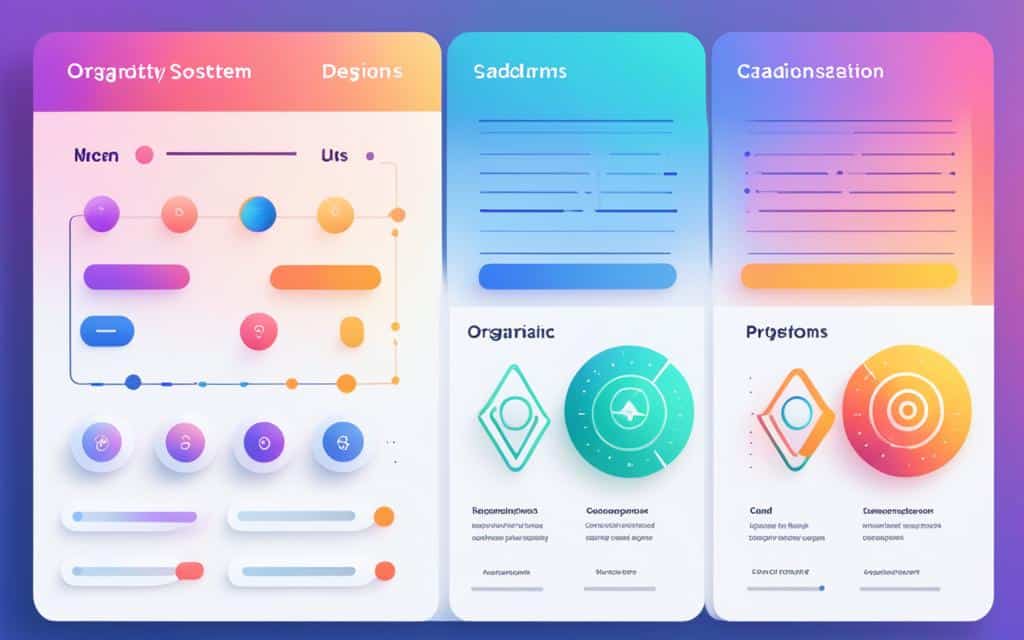Table of Contents
Design tokens are an essential component of a design system as they provide a single source of truth for design decisions. Managing design tokens efficiently is crucial for maintaining consistency and efficiency in workflows. This section will explore techniques and resources for effectively organizing and managing design tokens in a design system.
Design tokens act as the atomic elements of design within a brand and represent design decisions in their simplest form. They serve as a single source of truth for design decisions and are essential for maintaining consistency across a product’s user interface. Design tokens help create a common language between designers and developers, enabling better collaboration and streamlining the design process.
The Importance of Design Tokens
Design tokens play a crucial role in the world of design. Serving as the atomic elements of design within a brand, they represent design decisions in their simplest and most fundamental form. Design tokens act as a single source of truth for these design decisions and are essential for maintaining consistency across a product’s user interface.
By leveraging design tokens, designers can establish a harmonious visual language that permeates throughout their projects. They help create a common language between designers and developers, enabling better collaboration and streamlining the design process.
Design tokens offer several key benefits:
- Consistency: Design tokens ensure a consistent look and feel across different components of a product. By defining and using design tokens, designers can establish a cohesive visual identity that resonates with their brand.
- Efficiency: With design tokens, designers can make changes in one place, and those changes will be automatically reflected across the entire product. This eliminates the need to manually update multiple instances and speeds up the design iteration process.
- Flexibility: Design tokens provide flexibility in adapting to different platforms and screen sizes. By adjusting the value of a design token, designers can easily customize the look and feel of their product without having to redesign individual components.
The Power of a Single Source of Truth
Design tokens act as that single source of truth, ensuring that design decisions are consistent and have a lasting impact throughout the entire development process.
Design tokens become an invaluable asset for projects of any scale. By defining color palettes, typography, spacing, and other design elements as tokens, designers can easily access and utilize these building blocks across their projects.
For example, a design token for a primary brand color could be defined as:
| Token Name | Value |
|---|---|
| Primary Color | #FF0000 |
By referencing this design token, designers can ensure that the primary brand color remains consistent across all components and screens, even if they decide to change the actual color value. This level of control and scalability simplifies the design process and empowers designers to focus on creating meaningful experiences.
Design tokens enable designers to make design decisions with confidence, knowing that changes made to a token will cascade throughout the entire product. This not only saves time and effort but also helps maintain a cohesive user experience, enhancing brand recognition and usability.
Overall, design tokens act as a guiding light for designers, aligning their design decisions with their brand’s visual identity and creating a solid foundation for the entire product.
Techniques for Managing Design Tokens
When it comes to managing design tokens, there are several techniques and resources that can assist designers in organizing and streamlining their workflow. While design tools like Figma serve as valuable platforms for exploring design solutions and creating digital assets, they may not be the most effective option when dealing with extensive collections of design tokens. In such cases, spreadsheets and databases offer better flexibility and control.
Spreadsheets are widely used for managing design tokens due to their ease of use and ability to handle large amounts of data. Designers can create comprehensive spreadsheets to catalog and organize design tokens based on various attributes. This method allows for easy searchability and provides a structured overview of the design system. Spreadsheets also enable the use of formulas and conditional formatting to automate certain aspects of token management.
In addition to spreadsheets, databases are powerful tools for managing design tokens. They provide the ability to establish relationships and link design tokens with other relevant information, such as component documentation or color palettes. Notion, a versatile tool for managing databases, offers a range of features that can be useful for design token management. Designers can create a database in Notion and link it to other databases or component libraries, ensuring consistency and accessibility throughout the design system.
To further aid in managing design tokens, there are dedicated plugins and tools available. Style Dictionary, for example, is a popular plugin that simplifies the integration of design tokens into development workflows. It helps bridge the gap between design and development by automatically generating CSS or Sass variables from design tokens, ensuring consistency and efficient front-end development.
Another useful tool is Tokens Studio, which provides a visual interface for managing design tokens and their relationships. It allows designers to define relationships between tokens and visualize dependencies, making it easier to understand and maintain a complex design system.
By incorporating these techniques and utilizing the appropriate tools, designers can effectively manage and organize design tokens, ensuring consistency and efficiency throughout the design process.
“Design tokens are the building blocks of a design system, and properly managing them is crucial for maintaining consistency and efficiency in workflows.”
Summary of Techniques for Managing Design Tokens
| Technique | Key Benefits |
|---|---|
| Spreadsheets |
|
| Databases (Notion) |
|
| Plugins (Style Dictionary) |
|
| Tools (Tokens Studio) |
|
Benefits of Using Spreadsheets for Design Token Management
Spreadsheets are a popular choice for managing design tokens due to their ease of use and ability to handle large amounts of data. They offer several benefits that contribute to efficient design token management:
1. Controlled Vocabulary
Spreadsheets allow designers to create a controlled vocabulary for design tokens. This means that the tokens can be organized into categories and sub-categories, ensuring a consistent and logical structure. By maintaining a clear and well-defined vocabulary, designers can easily locate and reference specific design tokens, improving the overall efficiency of the design process.
2. Automated Naming Systems
One of the key advantages of using spreadsheets for design token management is the ability to implement automated naming systems. These systems save time and effort by generating consistent and standardized names for design tokens. With automated naming, designers can ensure that token names follow a predetermined format, making it easier to understand their purpose and functionality.
3. Multiple Formats Export
Spreadsheets provide the flexibility of exporting data in various formats. Designers can export design tokens in different file types, such as CSV or JSON, based on the requirements of their projects. This feature simplifies the process of sharing design tokens with developers or other stakeholders, ensuring data consistency across different platforms and tools.
“Spreadsheets offer a controlled vocabulary, automated naming, and multiple formats export, making them an excellent choice for managing design tokens efficiently.”
Overall, spreadsheets offer a user-friendly interface, efficient organization of design tokens through controlled vocabularies, automated naming systems, and the ability to export data in multiple formats. These features make spreadsheets a valuable tool for design token management, streamlining workflows and enhancing collaboration between designers and developers.
Leveraging Notion for Design Token Management
Notion, though not specifically designed for design token management, can be a powerful tool for linking design tokens with other databases and establishing relations. It offers the flexibility to create a taxonomy and starter set of design tokens, making it easier to manage and update them. Notion’s ability to link different databases and components allows for automatic linking of design tokens with other relevant information, such as component documentation.
“Notion’s versatility makes it an ideal solution for design token management. By leveraging its database linking capabilities, designers can create dynamic connections between design tokens and other relevant data, streamlining the documentation process and ensuring consistency. It serves as a central hub for design teams to collaborate and access vital information related to design tokens and their usage throughout the system.”
By utilizing Notion’s features, designers can create a comprehensive repository for design tokens, enhancing efficiency and facilitating collaboration among team members. The ability to link design tokens with other relevant databases enables a holistic approach to design token management, ensuring that information is organized and easily accessible.
Benefits of Using Notion for Design Token Management:
- Efficient organization and management of design tokens
- Flexible taxonomy creation
- Seamless linkage with other databases and components
- Improved documentation process
- Enhanced collaboration among design teams
Notion Features for Design Token Management
| Feature | Description |
|---|---|
| Database Linking | Connect design tokens with other relevant databases for streamlined information access |
| Flexible Taxonomy | Create an organized structure for design tokens using customizable categories and tags |
| Starter Set Creation | Easily define and update a starting collection of design tokens |
| Component Documentation | Link design tokens with component documentation for comprehensive reference |
| Team Collaboration | Enable multiple designers to work together, accessing and contributing design token information |
Streamlining the Design Process with Style Dictionary
When it comes to translating design tokens into CSS or Sass variables for front-end development, Style Dictionary proves to be an invaluable tool. Its ability to bridge the gap between design and development automates the process of generating variables, ultimately saving time and effort in maintaining consistency across different data sets.
By implementing Style Dictionary into the design process, designers and developers can streamline their workflows and ensure that design tokens are accurately implemented in the final product.
One of the key advantages of using Style Dictionary is its capability to centralize design token translation. With Style Dictionary, designers can define and organize their design tokens in a way that reflects their design system’s specific needs and conventions.
Through the Style Dictionary configuration, designers can specify the platform-specific output formats for their design tokens, such as CSS variables, Sass variables, or even JSON files. This flexibility allows them to seamlessly integrate design tokens into their front-end development pipeline.
Additionally, Style Dictionary provides a command-line interface that allows for quick and effortless generation of design token assets. This eliminates the need for manual and error-prone translation of design tokens into code, freeing up designers’ time to focus on more creative and high-level design tasks.
Here is an example of how Style Dictionary can be used to streamline the design process:
- An initial set of design tokens is defined using Style Dictionary’s syntax and configuration.
- The design tokens are automatically translated into CSS variables using the defined Style Dictionary configuration.
- The CSS variables are then implemented in the front-end codebase, providing a standardized and consistent design language for the developers to work with.
The integration of Style Dictionary into the design process ensures that design tokens are accurately translated and seamlessly implemented across different platforms and systems. This promotes efficient collaboration between designers and developers, reducing the risk of inconsistencies and enhancing the overall quality of the final product.
| Benefits of Using Style Dictionary | Controlled Design Tokens | Automated Translation | Efficient Collaboration |
|---|---|---|---|
| Enables consistent use of design tokens throughout the project | Streamlines the process of translating design tokens into code | Reduces manual effort and potential human errors | Enhances collaboration between designers and developers |
| Provides a centralized and easily maintainable repository for design tokens | Allows for the generation of platform-specific output formats | Improves efficiency by automating repetitive tasks | Promotes a shared understanding of the design language |
| Achieves consistency in design decisions across different data sets | Integrates seamlessly into the front-end development workflow | Facilitates cross-functional collaboration | Reduces the need for manual code updates |
Conclusion
Managing design tokens is critical for achieving an efficient and consistent design system. By implementing the techniques and resources discussed in this article, designers can streamline their design process and ensure consistency across projects.
Spreadsheets and databases offer effective solutions for organizing and maintaining design tokens. They provide a controlled vocabulary and allow for automated naming, saving time and ensuring consistency in design decisions. Additionally, the flexibility of tools like Notion allows for linking design tokens with other relevant information, enhancing documentation and project management.
Integrating design and development processes is also key to efficiency and consistency. Style Dictionary serves as a bridge between designers and developers, enabling the translation of design tokens into front-end development code. By leveraging tools like Style Dictionary, designers can ensure the accurate implementation of design decisions, ultimately enhancing the final product.
In conclusion, managing design tokens is essential for establishing an efficient and consistent design system. By leveraging tools like spreadsheets, databases, Notion, and Style Dictionary, designers can create a streamlined workflow that maximizes efficiency and promotes consistency throughout the design process.
FAQ
What are design tokens?
Design tokens are the atomic elements of design within a brand. They represent design decisions in their simplest form and act as a single source of truth for maintaining consistency across a product’s user interface.
Why are design tokens important in a design system?
Design tokens are essential for maintaining consistency and efficiency in workflows. They create a common language between designers and developers, enabling better collaboration and streamlining the design process.
What techniques can be used to manage design tokens?
Various techniques can be used to manage design tokens. Design tools like Figma can be helpful for exploring potential solutions and creating digital assets. Spreadsheets and databases are better suited for managing extensive collections of design tokens. Notion, a versatile tool for managing databases, can be used to link design tokens with other relevant information. Plugins like Style Dictionary and Tokens Studio can also be used to integrate design and development tools.
Why are spreadsheets a popular choice for managing design tokens?
Spreadsheets offer ease of use and the ability to handle large amounts of data. They allow for the creation of controlled vocabularies, ensuring an organized approach to managing design tokens. Automated naming systems save time and ensure consistency in naming conventions. Spreadsheets also allow for data export in various formats, making it easier to share and maintain data consistency across different platforms.
How can Notion be leveraged for design token management?
Notion, although not specifically designed for design token management, can be a powerful tool for linking design tokens with other databases and establishing relations. It provides the flexibility to create a taxonomy and starter set of design tokens, making it easier to manage and update them. Notion’s ability to link different databases and components allows for automatic linking of design tokens with other relevant information, such as component documentation.
How does Style Dictionary streamline the design process?
Style Dictionary serves as a bridge between design and development by automating the process of generating CSS or Sass variables from design tokens. This saves time and effort in maintaining consistency across different data sets. By using Style Dictionary, designers and developers can streamline the design process, ensuring design tokens are accurately implemented in the final product.
What are the benefits of managing design tokens in a design system?
Managing design tokens is crucial for maintaining an efficient and consistent design system. By implementing the techniques and resources discussed, designers can streamline their design process and ensure consistency across projects. Spreadsheets, databases, Notion, and Style Dictionary provide effective solutions for organizing and maintaining design tokens, resulting in a more efficient workflow and enhancing the overall design process.













